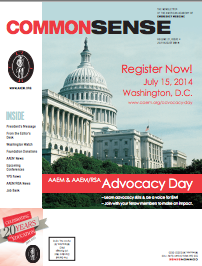 |
| Originally published in Jul/Aug 2014 Common Sense |
Author: Andrew W Phillips, MD MEd
AAEM/RSA Publications Committee Chair
On a recent whim I searched Google for “emergency medicine education fellowship” and “learning theory.” During this entirely non-rigorous search I found that most of the first forty hits were programs specifically mentioning their emphasis on teaching Adult Learning Theory. In fact, even most non-educators reading this have probably heard of ALT. I would wager, however, that you have not heard of Situated Cognition, Cognitive Apprenticeship, Social Learning Theory, or Sociocultural Theory.
This is a two-part series that will first explore the criticisms of ALT, and later offer a breadth of alternatives that together inform us well about how we (adults and children) learn.
Andragogy has multiple definitions that depend on decade and geographic location,[1] but is essentially the study of adult learning. While the concept of andragogy began with Plato, the term was coined in 1833 by Alexander Kapp and later refined by Malcolm Knowles in 1970.[2] Although andragogy and ALT are often used synonymously, ALT as presented by Knowles and other education and psychology researchers is really one of many theoretical attempts to explain learning by adults.[1]
ALT begins with the concept that children and adults fundamentally learn differently. The premise is that adults and children have existential differences and therefore learn differently, which spawned a heated debate in the 1980s about whether any subgroup (race, sex, etc.) with existential differences deserves its own learning theory.[3] Note that there are social differences between different groups with different existential ideas as well; this is important for later theories.
If we assume that andragogy exists because there is a life-outlook difference between children and adults, we must accept that learning theories such as gynagogy, infantagogy, adolescagogy, and geragogy are also possibilities.[2] Simply reading the list of a few examples out loud can make one question the existence of so many different theoretical differences between groups of learners.
In the setting of great criticism from cognitive psychologists, educational psychologists, and even his mentor, Dr. Knowles de-emphasized the difference between andragogy and pedagogy. Prior to the 1970’s, pedagogy was largely interpreted as education of any human, not just children.[3] Despite naming his initial publication “The Modern Practice of Adult Education: Andragogy Versus Pedagogy,” Knowles later wrote:
So I am not saying that pedagogy is for children and andragogy is for adults, since some pedagogical assumptions are realistic for adults in some situations and some andragogical assumptions are realistic for children in some situations. And I am certainly not saying that pedagogy is bad and andragogy is good; each is appropriate given the relevant assumptions (Knowles, 1979, p. 52).[4]
Adult Learning Theory Tenets
Regardless of the debate around andragogy’s existence, and by extension an entire theory that could explain it, let us examine the assumptions that ALT posits. According to Knowles, an adult learner:
- has an independent self-concept which allows for self-directed learning
- has a rich repository of life experience by which s/he learns
- has learning needs related to changing social roles
- is problem-centered and interested in immediate application
- is internally motivated to learn.
No research to date has shown that these assumptions do not apply to children.[2] An excellent critique by a nurse educator breaks down each of Knowles’ tenets with evidence as early as 1993,[2] and this is repeated in medical education literature in 1999 and 2006.[5,6] As a simple thought experiment, if you have ever bemoaned a mandatory meeting that you knew in your heart of hearts was good for you, we can immediately scratch assumptions 1 and 5.
Why does the medical community care so much for ALT, and in an evidence-based practice jump feet first into it? Probably because it makes us feel special as adults — better than children.[2] It is also easier to understand and remember: Adult Learning Theory — learning for adults.
The grosser sin is the misinterpretation of ALT, because that impacts our learning in a palpable way. How many times have you heard an educator say, “You’re an adult learner; do your reading,” or “You’re an adult learner; figure it out.” Self-directed learning is merely a component of ALT, and has moved into its own area of research since the ALT fallout of the 1980s, with it’s own annual International Symposium on Self-Directed Learning. A review in 2000, however, already noted steady decline in publications in this area of research,[7] suggesting again that the tenets of ALT may not provide a solid theoretical foundation for learning
This is not to say that the tenets of Adult Learning Theory have no value — perhaps as prescriptive teaching methods (self-directed learning), techniques, or a general utility in mindset. However, we risk ignoring much of what the education community knows when we accept ALT as a completely valid theory and build curricula exclusively around it.
The other learning theories presently being explored by cognitive psychologists, learning scientists, and educational psychologists have much more to offer: social components, building cues, etc. We will examine the strengths and weaknesses of those theories in the next issue.
References
- Merriam SB. Andragogy and Self-Directed Learning: Pillars of Adult Learning Theory. New Directions For Adult & Continuing Education. 2002 Jan 1;2001(89):3-14.
- Milligan F. In defence of andragogy. Nurse Educ Today. 1995 Feb 1;15(1):22-7.
- Davenport J, Davenport JA. A chronology and analysis of the andragogy debate. Adult Education Quarterly. Sage Publications; 1985;35(3):152-9.
- Knowles MS. Andragogy revisited part II. Adult Education. 30(1):52-3.
- Norman GR. The adult learner: a mythical species. Acad Med. 1999 Aug;74(8):886-9.
- Bleakley A. Broadening conceptions of learning in medical education: the message from teamworking. Med Educ. 2006 Feb;40(2):150-7.
- RB B, Editor. Two decades of literature on SDL: A content analysis. 14 Ed. Boynton Beach, FL, USA.
